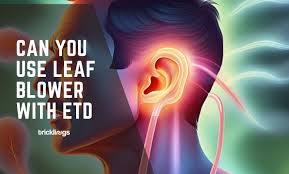Eustachian Tube Dysfunction and Leaf Blowers: Risks and Precautions

Eustachian Tube Dysfunction (ETD) is a condition that affects the small passageways connecting the middle ear to the back of the throat. These tubes help regulate ear pressure and drain fluids, but when they become blocked or fail to function properly, it can lead to symptoms such as ear pain, pressure, dizziness, and even hearing issues. If you have ETD, you may wonder: can you use a leaf blower with Eustachian tube dysfunction? This article explores the risks and precautions associated with using a leaf blower when dealing with this condition.
How Leaf Blowers Can Affect Eustachian Tube Dysfunction
Leaf blowers produce strong air currents and loud noise, both of which can impact individuals with ETD in several ways:
Suden Pressure Changes
Leaf blowers create powerful gusts of air that can cause rapid pressure fluctuations in your surroundings. If you have ETD, your ears may struggle to equalize pressure properly, leading to discomfort, pain, or a feeling of fullness in the ears.
Noise-Induced Ear Strain
Most leaf blowers operate at noise levels exceeding 90 decibels, which can be harmful to hearing. For those with ETD, loud sounds may worsen symptoms by causing further stress on the ears, potentially leading to temporary or permanent hearing sensitivity.
Increased Risk of Ear Barotrauma
Barotrauma occurs when there is a sudden change in ear pressure, leading to ear pain or damage. This is commonly experienced in activities like flying or scuba diving, but powerful air movement from a leaf blower could also trigger similar effects, making symptoms worse for those with ETD.
Precautions to Take When Using a Leaf Blower with ETD
If you must use a leaf blower despite having Eustachian Tube Dysfunction, here are some precautions to reduce potential risks:
Wear Proper Hearing Protection
Use noise-canceling earmuffs or earplugs to reduce the impact of loud sounds. This can help protect your ears from further strain and discomfort.
Use a Low-Power Setting or Alternative Equipment
If possible, opt for a leaf blower with adjustable speed settings to minimize powerful air pressure changes. Alternatively, consider using a rake or electric-powered blower with lower air output to reduce strain on your ears.
Take Breaks and Monitor Symptoms
Avoid prolonged exposure by taking breaks during yard work. If you experience ear pain, dizziness, or increased pressure, stop using the blower immediately and rest.
Maintain Good Ear Health
Practice techniques to help your Eustachian tubes function better, such as:
- Swallowing or yawning frequently to equalize ear pressure.
- Using nasal decongestants or antihistamines (if recommended by a doctor).
- Staying hydrated to keep mucus membranes moist and functioning properly.
Consult a Doctor If Symptoms Worsen
If you find that using a leaf blower significantly worsens your ETD symptoms, consult an ENT (ear, nose, and throat) specialist. They can provide personalized advice and suggest alternative ways to manage your condition while performing outdoor work.
Conclusion
So, can you use a leaf blower with Eustachian tube dysfunction? While it is possible, it does come with risks, including ear pressure imbalances, noise-induced discomfort, and barotrauma. To minimize these risks, it is crucial to take necessary precautions, such as wearing hearing protection, limiting exposure, and monitoring your symptoms. If your ETD is severe, consider alternative methods for yard maintenance or seek medical advice for safer options.
Would you like any modifications or additional information in this articl




